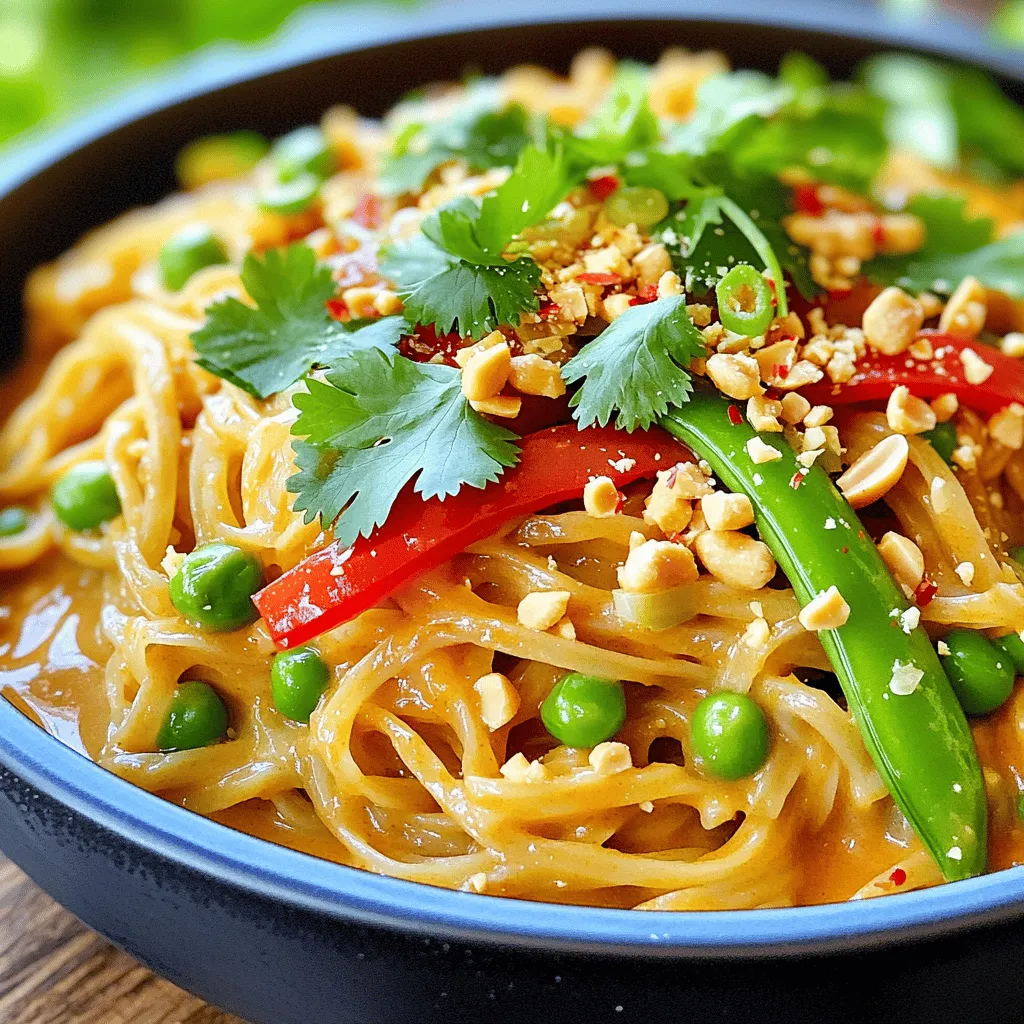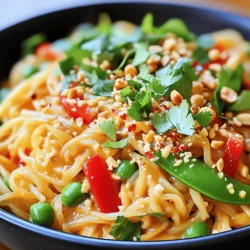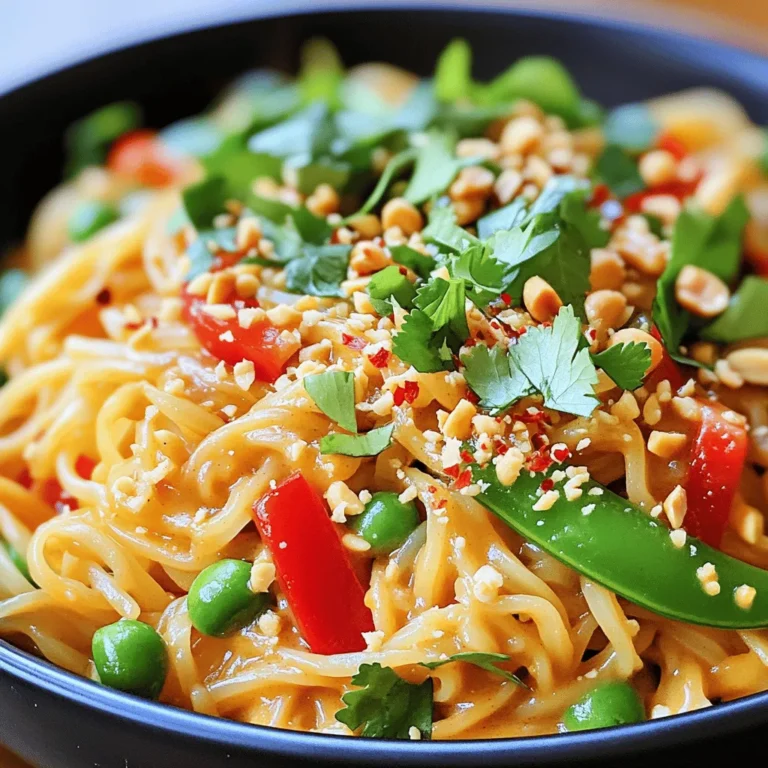Looking for a quick and tasty meal? Thai Peanut Noodles are your answer! This dish is packed with flavor and can be made in under 30 minutes. With just a few simple ingredients like rice noodles and creamy peanut butter, you’ll impress everyone at the dinner table. In this post, I’ll guide you through each step to create this delicious meal. Let’s dive into the flavors and start cooking!
Ingredients
Main Ingredients
– 8 oz rice noodles
– 1/2 cup creamy peanut butter
– 2 tablespoons soy sauce
– 1 tablespoon lime juice
Additional Ingredients
– 2 tablespoons honey or maple syrup
– 1 tablespoon sesame oil
– 2 teaspoons grated fresh ginger
– 1 red bell pepper, thinly sliced
– 1 cup snap peas, trimmed
– 1 cup shredded carrots
– 1/4 cup chopped green onions
– 1/4 cup crushed peanuts for garnish
– Fresh cilantro leaves for garnish (optional)
– Crushed red pepper flakes (to taste)
I love how simple and quick this recipe is. You only need a few key ingredients to make a big impact. Rice noodles form the base of this dish, giving it a nice, chewy texture. Creamy peanut butter adds a rich flavor that makes every bite satisfying.
Soy sauce brings umami, while lime juice adds a zesty kick. For a hint of sweetness, honey or maple syrup works wonders. Don’t forget sesame oil for a nutty aroma and fresh ginger for a bright, spicy touch.
The colorful veggies—red bell pepper, snap peas, and shredded carrots—boost flavor and nutrition. They also make the dish look vibrant and appealing.
Top it off with green onions and crushed peanuts for crunch. If you want an extra layer of flavor, fresh cilantro is a nice touch. You can also add crushed red pepper flakes to adjust the heat to your liking.
Step-by-Step Instructions
Cooking the Noodles
Start by boiling a large pot of water. Add 8 oz of rice noodles to the boiling water. Cook them as the package says, usually for 7 to 10 minutes. You want them to be al dente. Once done, drain the noodles and rinse them under cold water. This stops the cooking and keeps them firm.
Preparing the Sauce
In a medium bowl, combine 1/2 cup of creamy peanut butter, 2 tablespoons of soy sauce, and 1 tablespoon of lime juice. Add 2 tablespoons of honey or maple syrup, 1 tablespoon of sesame oil, and 2 teaspoons of grated fresh ginger. Whisk everything together until smooth. If the sauce is thick, you can add a bit of warm water to get it just right.
Sautéing the Vegetables
Grab a large skillet or wok and heat 1 tablespoon of sesame oil over medium heat. Once hot, toss in the sliced red bell pepper, trimmed snap peas, and shredded carrots. Sauté these for about 3 to 4 minutes. You want the veggies to be tender but still crisp.
Combining Noodles and Sauce
Add the cooked rice noodles to the skillet with your sautéed veggies. Pour the peanut sauce over the noodles. Gently toss everything together until the noodles are coated in sauce. Heat it through for about 2 to 3 minutes.
Garnishing and Serving
Remove the pan from heat. Transfer the noodles to serving plates. Top with 1/4 cup of chopped green onions and 1/4 cup of crushed peanuts. You can add fresh cilantro leaves if you like. For a spicy kick, sprinkle crushed red pepper flakes on top.
Tips & Tricks
Perfecting the Sauce
To get the right sauce, you may need to adjust its thickness. If it feels too thick, add warm water slowly. Stir until you reach a smooth consistency. If you want a bolder taste, try adding more soy sauce or lime juice. For a twist, mix in some sriracha for heat or coconut milk for creaminess. You can also swap peanut butter for almond or sunflower seed butter if you are allergic.
Cooking Techniques
When cooking rice noodles, always boil plenty of water. It helps prevent sticking. Cook them just until tender, usually 7-10 minutes. After draining, rinse them with cold water. This stops the cooking process and keeps them from getting mushy. For your veggies, cut them into similar sizes. This helps them cook evenly. Stir-frying in a hot pan keeps them crisp and colorful.
Meal Prep Suggestions
If you have leftovers, store them in an airtight container. They will stay fresh in the fridge for about three days. For reheating, use a skillet over medium heat. Add a splash of water to help steam the ingredients. You can also microwave them for a quick meal, but add a little water to keep them moist. Enjoy your Thai peanut noodles any time!

Variations
Protein Add-Ins
You can easily boost your Thai peanut noodles with protein. Here are some tasty options:
– Chicken: Cut chicken breast into thin strips. Sauté until golden brown. Add it to your noodles for a hearty meal.
– Tofu: Firm tofu works great. Cube it and pan-fry until crispy. This adds a nice texture.
– Shrimp: Peel and devein shrimp. Cook them in a pan until they turn pink. They pair perfectly with the peanut sauce.
Adding protein not only enriches the dish but also makes it more filling.
Flavor Enhancements
To make your noodles shine, try these flavor boosts:
– Fresh lime zest: Grate some lime peel and sprinkle it on top. This adds a fresh burst of flavor.
– Chili paste: Stir in a spoonful of chili paste. This brings heat and depth to your dish. Adjust to your taste!
These small changes can elevate your meal from good to great.
Vegan and Gluten-Free Options
Making this dish fit your diet is easy. Here are some swaps:
– Vegan: Use maple syrup instead of honey. This keeps the dish sweet while staying plant-based.
– Gluten-free: Choose gluten-free soy sauce. This keeps the flavor without the gluten.
– Rice noodles: They are naturally gluten-free. Just ensure they are labeled as such.
These simple swaps help everyone enjoy Thai peanut noodles, regardless of dietary needs.
Storage Info
Storing Leftovers
To keep your Thai peanut noodles fresh, refrigerate them right away. Place the noodles in an airtight container. Make sure to separate the sauce from the noodles if possible. This can help keep the noodles from getting mushy. When stored properly, leftovers can last for about three to four days in the fridge. Before serving, just reheat them in the microwave or on the stove.
Freezing Recommendations
You can also freeze Thai peanut noodles. Start by letting them cool completely. Then, put them in freezer-safe bags or containers. Remove as much air as you can to prevent freezer burn. They can stay fresh for up to three months in the freezer. When you’re ready to eat, defrost them in the fridge overnight. Reheat gently on the stove, adding a splash of water if needed.
Shelf Life Tips
To keep your noodles fresh for longer, store them in a cool, dry place. Try to avoid direct sunlight. If you notice any signs of mold or an off smell, throw them away. Always check the expiration date on your ingredients, especially the peanut butter. For the best taste, use your cooked noodles within a few days.
FAQs
How do I make gluten-free Thai peanut noodles?
To make gluten-free Thai peanut noodles, use gluten-free rice noodles. Look for noodles made from rice or other gluten-free grains. Check the label to ensure they contain no wheat. Also, use gluten-free soy sauce. Tamari is a great option. This way, you enjoy the same tasty flavors without gluten.
Can I use spaghetti instead of rice noodles?
Yes, you can use spaghetti instead of rice noodles. The texture will change, but it still tastes good. Cook spaghetti according to package instructions. Rinse and drain like rice noodles. The sauce will coat the spaghetti well, making it a delicious option.
What can I substitute for peanut butter?
If you need a substitute for peanut butter, try almond butter or sunflower seed butter. Both options give a similar creamy texture. They also add a nice flavor. If you have a nut allergy, sunflower seed butter works best. It can create a tasty sauce.
How spicy are Thai peanut noodles?
The spice level of Thai peanut noodles varies. It depends on how much crushed red pepper you add. You can control the heat by adjusting the amount to your taste. Start with a little, then add more if you like it spicy. The dish can be mild or hot, based on your choice.
Can I serve Thai peanut noodles cold?
Yes, you can serve Thai peanut noodles cold. This makes a great dish for warm days. Just prepare the noodles and sauce as usual, then let them cool. Toss everything together and chill in the fridge. This gives a refreshing twist to the meal. Enjoy it as a salad or cold dish!
This blog covered Thai peanut noodles, from ingredients to storage tips. We discussed the main ingredients like rice noodles and peanut butter, with extra flavors from fresh veggies and spices. You learned how to cook and combine everything in simple steps. We also shared meal prep and variation ideas to suit different tastes.
In conclusion, these noodles are versatile and easy to make. Enjoy experimenting with your favorite ingredients and flavors to make this dish your own.


